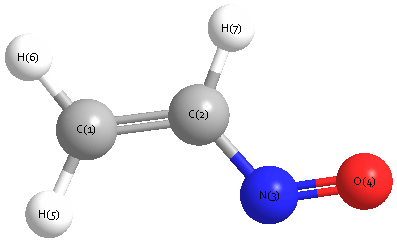Vibrational Frequencies calculated at TPSSh/cc-pVQZ
| Mode Number |
Symmetry |
Frequency
(cm-1) |
Scaled Frequency
(cm-1) |
IR Intensities
(km mol-1) |
Raman Act
(Å4/u) |
Dep P |
Dep U |
|---|
| 1 |
A' |
3241 |
3241 |
1.16 |
62.07 |
0.67 |
0.81 |
| 2 |
A' |
3151 |
3151 |
5.03 |
181.16 |
0.13 |
0.22 |
| 3 |
A' |
3135 |
3135 |
6.01 |
23.25 |
0.75 |
0.86 |
| 4 |
A' |
1667 |
1667 |
1.91 |
30.34 |
0.10 |
0.18 |
| 5 |
A' |
1555 |
1555 |
123.54 |
58.99 |
0.38 |
0.55 |
| 6 |
A' |
1422 |
1422 |
23.45 |
23.24 |
0.40 |
0.57 |
| 7 |
A' |
1288 |
1288 |
1.53 |
8.52 |
0.31 |
0.47 |
| 8 |
A' |
1137 |
1137 |
77.49 |
25.21 |
0.42 |
0.59 |
| 9 |
A' |
886 |
886 |
33.05 |
0.28 |
0.39 |
0.57 |
| 10 |
A' |
603 |
603 |
1.05 |
8.87 |
0.17 |
0.29 |
| 11 |
A' |
337 |
337 |
1.21 |
0.99 |
0.70 |
0.82 |
| 12 |
A" |
1014 |
1014 |
34.40 |
2.17 |
0.75 |
0.86 |
| 13 |
A" |
1009 |
1009 |
15.21 |
1.13 |
0.75 |
0.86 |
| 14 |
A" |
680 |
680 |
0.76 |
1.97 |
0.75 |
0.86 |
| 15 |
A" |
180 |
180 |
0.08 |
0.53 |
0.75 |
0.86 |
Unscaled Zero Point Vibrational Energy (zpe) 10652.0 cm
-1
Scaled (by 1) Zero Point Vibrational Energy (zpe) 10652.0 cm
-1
See section
III.C.1 List or set vibrational scaling factors
to change the scale factors used here.
See section
III.C.2
Calculate a vibrational scaling factor for a given set of molecules
to determine the least squares best scaling factor.
Charges, Dipole, Quadrupole and Polarizability
Charges from optimized geometry at TPSSh/cc-pVQZ
Charges (e)
| Number |
Element |
Mulliken |
CHELPG |
AIM |
ESP |
| 1 |
C |
-0.332 |
|
|
|
| 2 |
C |
-0.101 |
|
|
|
| 3 |
N |
0.041 |
|
|
|
| 4 |
O |
-0.205 |
|
|
|
| 5 |
H |
0.198 |
|
|
|
| 6 |
H |
0.230 |
|
|
|
| 7 |
H |
0.169 |
|
|
|
Electric dipole moments
Electric dipole components in Debye
(What's a Debye? See section
VII.A.3)
| |
x |
y |
z |
Total |
| |
1.424 |
2.930 |
0.000 |
3.258 |
| CHELPG |
|
|
|
|
| AIM |
|
|
|
|
| ESP |
|
|
|
|
Electric Quadrupole moment
Quadrupole components in D Å
Polarizabilities
Components of the polarizability tensor.
Units are
Å
3 (Angstrom cubed)
Change units.
| |
x |
y |
z |
| x |
7.158 |
2.109 |
0.000 |
| y |
2.109 |
6.860 |
0.000 |
| z |
0.000 |
0.000 |
3.369 |
<r2> (average value of r
2) Å
2
| <r2> |
75.964 |
| (<r2>)1/2 |
8.716 |
